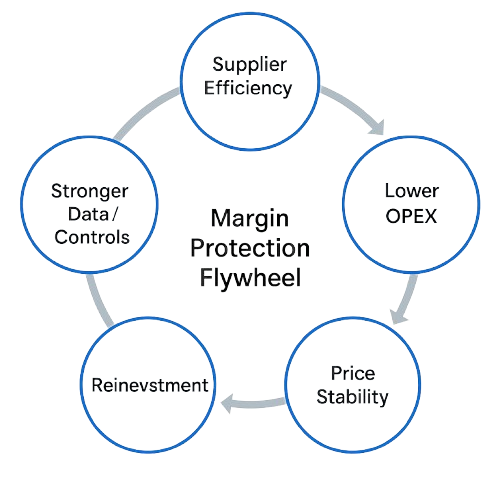Lower Risk, More Resilience: Evidence that Low‑Carbon Suppliers Help Your Company Win

Sustainable, low-carbon companies are systematically lower risk—financially, operationally, and regulatorily—and more resilient partners.
Three levers compound this advantage: cost and capital stability, supply continuity, and assurance-grade data and controls.
Across industries, leading organizations are now extending these benefits through their supply chains. Rather than treating sustainability as a compliance exercise, they are building programs that enable suppliers to measure, plan, and reduce emissions—turning decarbonization into a driver of performance.
The most effective leaders embed sustainability directly into commercial decisions using internal carbon pricing, product- and service-level footprints, and clear contractual expectations, rewarding suppliers that deliver verified progress.
The results of resilient supplier networks are tangible: fewer disruptions, more stable pricing, audit-ready data, stronger brands, and greater confidence from investors, lenders, and regulators.
Why now? Managing the new normal
The global trading environment has entered a phase of chronic volatility—tariffs, supply shocks, and extreme weather now flow straight into unit cost and margin risk. Investors and lenders are demanding proof of resilience, not just ESG intent.
Procurement teams are responding by embedding sustainability data into category strategies and capital decisions. The digital tools exist—hybrid calculations, auditable carbon footprints, supplier dashboards—and they are turning resilience into a measurable, bankable advantage.
In this guide, we’ll outline the mounting evidence that proves the business case for sustainability, aside from climate directives and incentives.
Supplier sustainability protects margins and reduces risk:
- Sustainable firms face fewer market shocks and lower downside risk. During the COVID-19 crash, firms with higher ESG ratings showed lower return volatility and better performance; additionally, successful engagements reduced downside Value-at-Risk by ~9% of the standard deviation versus controls. OUP Academic
- Higher maturity leads to lower financing costs. McKinsey reports that stronger ESG performance is associated with ~10% lower cost of capital as investors/lenders perceive lower long-term risk. McKinsey & Company
- Climate programs generate tangible savings. Among Fortune 100 companies reporting climate/energy targets, initiatives have delivered ~$1.1 billion in annual savings alongside large emissions cuts. wwf.mg
- Operations savings show up quickly. Capgemini finds organizations embedding sustainability realize 8-20% savings across waste, energy, and supply-chain costs. Capgemini
Lower‑carbon supplier operations protect margins:

- Renewables reduce fuel‑price volatility and provide cost certainty. Lazard’s 2025 LCOE+ shows new utility‑scale wind and solar are typically the lowest‑cost new generation in the U.S., even without subsidies. (Lazard)
- Freight efficiency and eco‑driving cut fuel OPEX and expedite exposure. U.S. DOE/EPA guidance indicates aggressive driving reductions can improve fuel economy materially; fleet driver training and telematics deliver persistent savings. (Energy.gov)
- Disruption is pervasive: BCI’s Supply Chain Resilience Report (2024) reports ~80% of organizations experienced supply‑chain disruption in the prior year—making resilience investments a form of margin insurance. (Resilience Forward)
- Transition risk is financial: BCG/WEF note that under accelerated climate action scenarios, carbon pricing alone can create up to ~50% of EBITDA in additional costs for unprepared businesses. (BCG)
Together, these findings point to a structural shift: supplier sustainability maturity now explains a growing share of variance in corporate risk profiles.
The following sections show how that plays out across financial, operational, regulatory, and social dimensions.
The Risk Logic: How Low‑Carbon Suppliers = Lower Risk
Financial risk & price stability
High-maturity suppliers have lower volatility, lower betas, and lower cost of capital. Sustainable operations protect against commodity and carbon cost shocks. Internal Carbon Pricing reveals hidden exposure and steers toward efficient, low-emission options.
Supply continuity & operations
Efficiency levers (route/load optimization, eco-driving, dual sourcing) reduce freight emissions and expedite costs. Smarter buffers and inventory design improve both resilience and working capital.
Regulatory & disclosure risk
High-maturity suppliers are better prepared for CSRD/SEC disclosure, carbon taxes, and audits. Supplier-specific data replaces proxies, improving auditability and comparability across sourcing events.
People & social stability
19% of global supply chain disruptions now trace to social issues. Social procurement and multi-tier visibility help avoid last-mile delivery risk and brand damage.
Governance maturity
Suppliers with mature sustainability systems have fewer ethical breaches, fewer regulatory penalties, and better resilience through shocks.
EcoVadis on Maturity and Resilience
Industry benchmarks reinforce the correlation between supplier sustainability maturity and lower risk.
EcoVadis, a leading sustainability rating firm, emphasizes that companies with higher performance are building more resilient businesses. In fact, EcoVadis’ latest index report highlights “a quiet but decisive shift as companies embrace sustainability to build resilience and create long-term value amid disruption.”
Echoing this, EcoVadis co-founder Pierre-François Thaler noted that sustainability has become critical to keeping supply chains running and mitigating shocks. “Even as the debate over business sustainability heats up, executives are focused on the reality–sustainability is what keeps supply chains running and customers on board,” says Thaler, adding that leading companies invest in transparency and accountability “to stay ahead of risks and disruption.”
In short, the EcoVadis perspective is that higher supplier maturity directly equates to lower risk and greater resilience in the face of today’s volatile operating environment.
Examples of successful supplier engagement programs
As you think about how to engage your suppliers and increase their resiliency, it can be helpful to reference other successful supplier engagement programs for ideas and inspiration:
- Schneider Electric’s Zero Carbon Project: Top 1,000 suppliers engaged; decarbonization enablement across the value chain. (Schneider Electric)
- Apple’s Supplier Clean Energy Program: 320+ suppliers committed; 95% of direct supplier spend powered by renewable electricity for Apple production (as of Mar 2024). (Apple)
- Thermo Fisher Scientific’s Responsible Sourcing Leadership Program: Integrated environmental performance deep into its sourcing strategy, committing to survey 80% of its direct-material suppliers for environmental performance by 2025. Through its Supplier Program, which accounts for over $2.2 billion in annual spend, it supports smaller partners with sustainability assessments, training, and inclusion initiatives, linking responsible sourcing directly to supplier capability building and resilience.(Thermo Fisher Scientific Responsible Sourcing Program)
Supplier Resiliency Leads to Value Chain Advantage
Companies that embed sustainability into the core of their supplier engagement unlock a compounding advantage: lower operational costs, more stable input pricing, and reduced exposure to disruptions.
The procurement leaders setting the pace—through carbon-adjusted sourcing, supplier enablement, and internal carbon pricing—are translating ESG maturity into tangible business value.
In this new operating environment, resilience and sustainability are not parallel goals; they are the same outcome viewed through different lenses.

